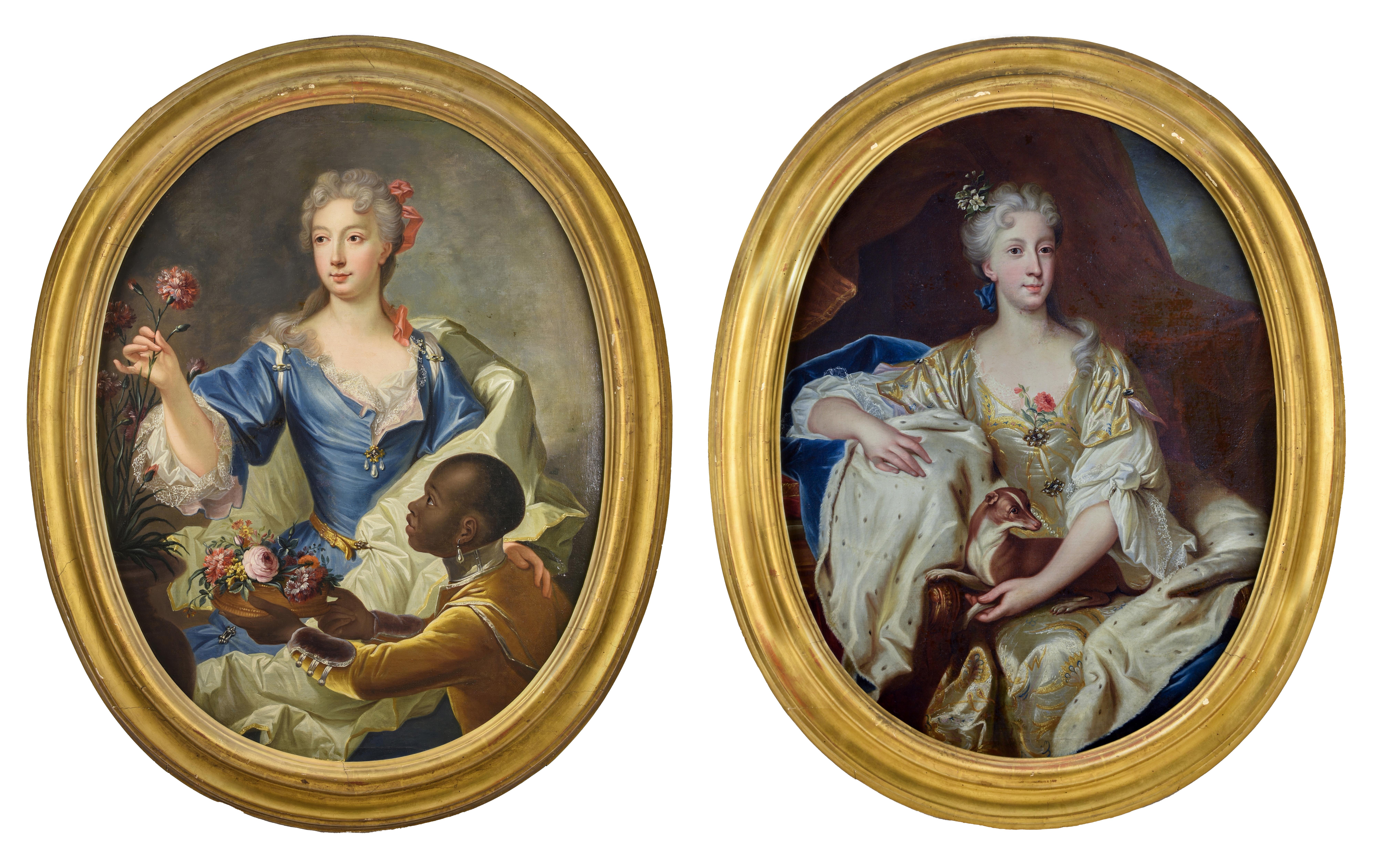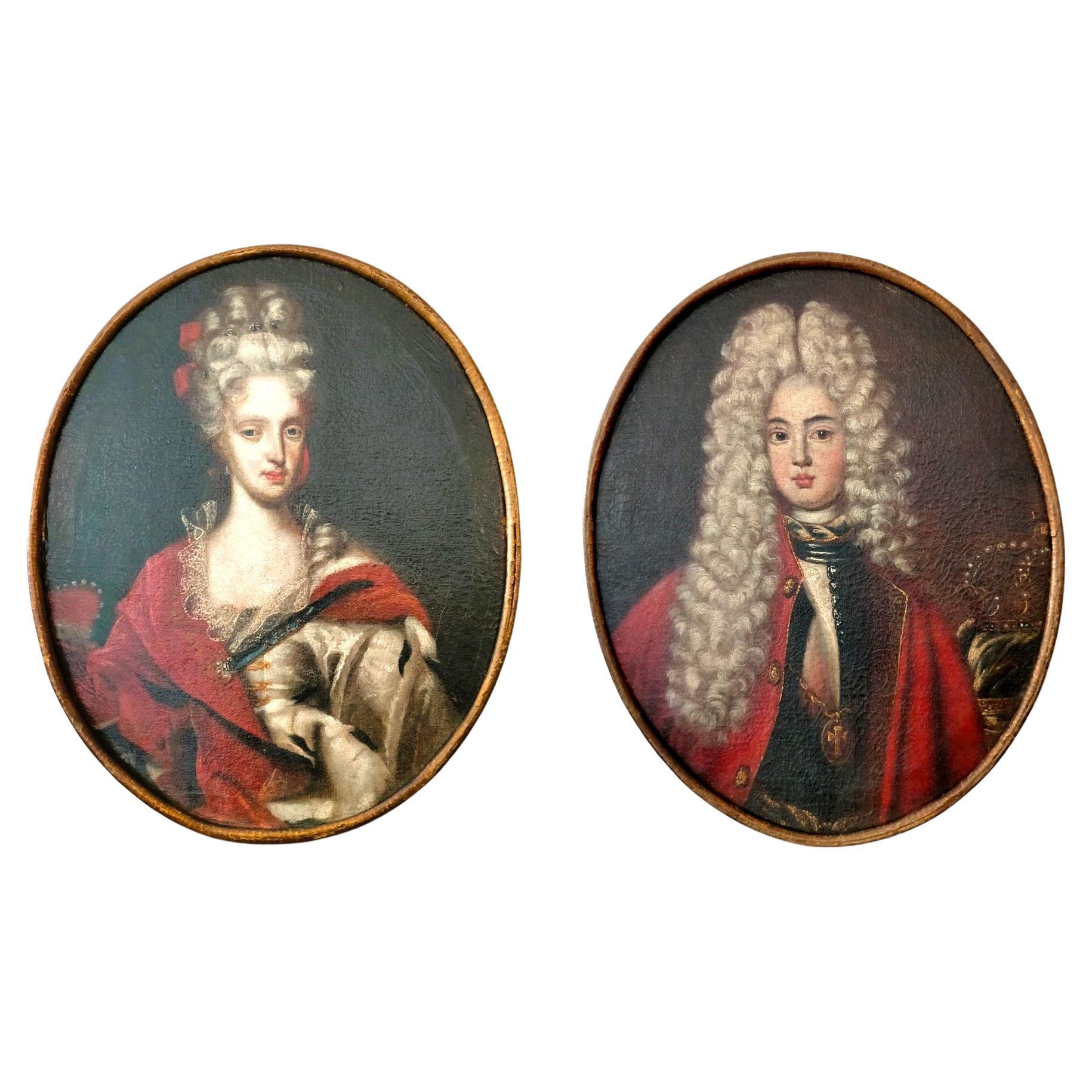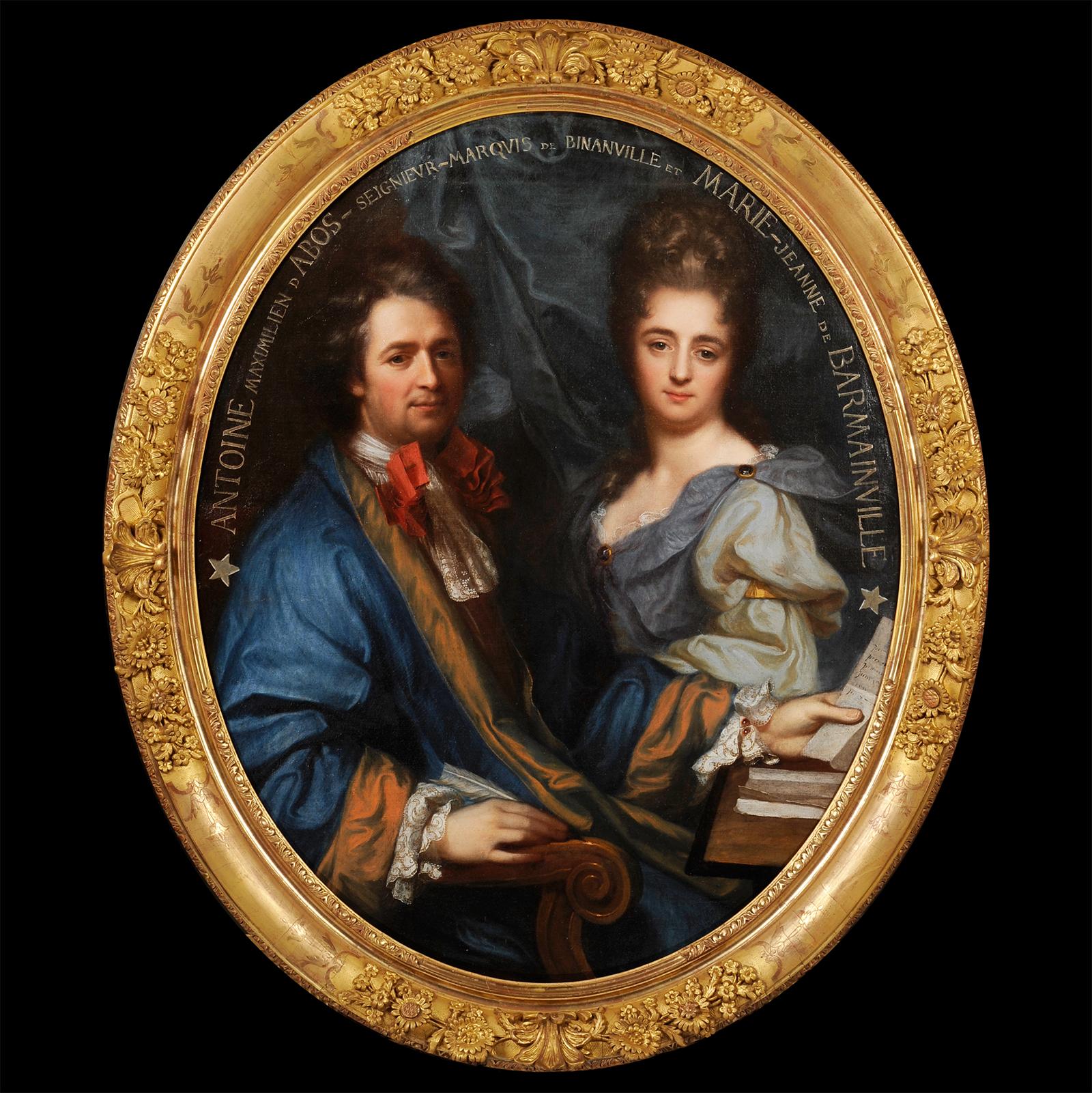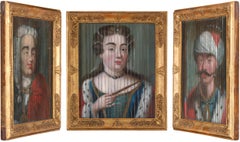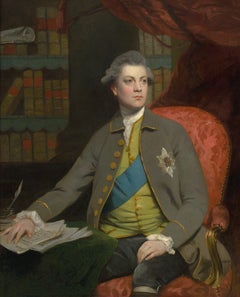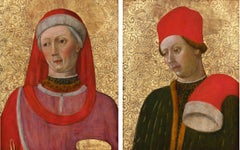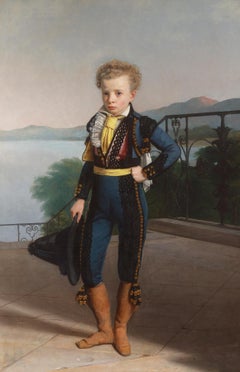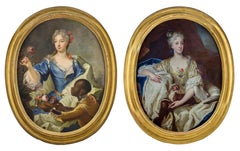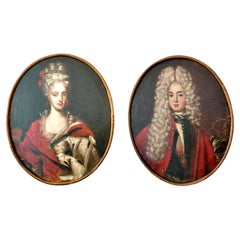Items Similar to Pair of Royal Portraits of the Duke and Duchess of Burgundy
Want more images or videos?
Request additional images or videos from the seller
1 of 10
Pair of Royal Portraits of the Duke and Duchess of Burgundy18th Century
18th Century
$88,500
£67,188.77
€76,996.34
CA$125,614.04
A$137,013.16
CHF 71,976.51
MX$1,657,578.36
NOK 900,449.84
SEK 850,203.84
DKK 574,724.63
About the Item
Follower of Pierre Gobert
18th century French
The Duke and Duchess of Burgundy
Oil on canvas
Refinement and intricacy characterize these royal portraits of France’s Louis, Duke of Burgundy and Marie Adélaïde of Savoy, Duchess of Burgundy. They are fashioned in the style of Pierre Gobert, who was the favored portraitist of King Louis XIV’s court, and a particular favorite of Marie Adélaïde, who sat for Gobert on more than one occasion. The pair are rendered with the utmost accuracy and opulence, draped in furs, fine textiles and jewels. These portraits indicate the couple’s importance in the history of France, not only as members of King Louis XIV’s court, but as the mother and father of the future King Louis XV.
Louis, Duke of Burgundy, was the eldest grandson of Louis XIV, and Marie Adélaïde was the eldest daughter of Victor Amadeus II, Duke of Savoy. The two married in December of 1697, when Louis was 15 years old and Marie only 12. These young portraits of the couple almost certainly depict them around the time of their marriage. Their match was a strategic one, connecting France and the Duchy of Savoy, which lay between France and Italy. Louis XIV was by all accounts very fond of the cheerful Marie Adélaïde, who eventually gave birth to three sons, the youngest of which was Louis XV.
Pierre Gobert was born in Fontainebleau to the sculptor Jean Gobert. He studied as a painter at the Royal Academy of Painting and Sculpture, and he became the preferred portraitist for the ladies of King Louis XIV’s court, including Marie Adélaïde. Demand was high for images of royalty in the 18th century, and other painters of the day imitated Gobert’s refined style for portraits such as the present pair.
18th century
Canvases: 34 1/2" high x 29 1/2" wide
Frames: 50 1/4" high x 37" wide
- Creation Year:18th Century
- Dimensions:Height: 50.25 in (127.64 cm)Width: 37 in (93.98 cm)Depth: 1.75 in (4.45 cm)
- Medium:
- After:Pierre Gobert (1662 - 1744, French)
- Period:
- Condition:
- Gallery Location:New Orleans, LA
- Reference Number:Seller: 31-33981stDibs: LU18610652222
About the Seller
5.0
Vetted Professional Seller
Every seller passes strict standards for authenticity and reliability
Established in 1912
1stDibs seller since 2013
19 sales on 1stDibs
Typical response time: 8 hours
- ShippingRetrieving quote...Shipping from: New Orleans, LA
- Return Policy
Authenticity Guarantee
In the unlikely event there’s an issue with an item’s authenticity, contact us within 1 year for a full refund. DetailsMoney-Back Guarantee
If your item is not as described, is damaged in transit, or does not arrive, contact us within 7 days for a full refund. Details24-Hour Cancellation
You have a 24-hour grace period in which to reconsider your purchase, with no questions asked.Vetted Professional Sellers
Our world-class sellers must adhere to strict standards for service and quality, maintaining the integrity of our listings.Price-Match Guarantee
If you find that a seller listed the same item for a lower price elsewhere, we’ll match it.Trusted Global Delivery
Our best-in-class carrier network provides specialized shipping options worldwide, including custom delivery.More From This Seller
View AllTri-Directional Portrait Commemorating the Russo-Turkish War
Located in New Orleans, LA
Austrian School
18th Century
Tri-Directional Portrait Commemorating the Russo-Turkish War
Oil on wooden strips
This extraordinary tri-directional portrait exemplifies the rare innovation known as a triscenorama, capturing a pivotal diplomatic moment through ingenious artistic technique. Employing triangularly cut wooden strips, this remarkable work simultaneously depicts three imperial figures central to the Russo-Turkish War of 1735-1739: Empress Anna Ivanovna Romanova of Russia when viewed directly, Holy Roman Emperor Charles VI from the left and Ottoman Sultan Mahmud I from the right, commemorating the Treaty of Nissa that concluded this significant European conflict.
The portrait utilizes an exceptionally rare optical technique that predates modern movable imaging technology. When observed from different angles, the painted triangular wooden strips create a transformative effect, revealing entirely different imperial portraits as the viewer shifts position. The precision required to execute such a work demonstrates remarkable technical mastery, as the artist had to conceptualize three distinct portraits as well as the meticulous arrangement of the panels. This sophisticated manipulation of perspective creates an interactive viewing experience considered revolutionary for its time.
Almost certainly created by an Austrian artist, this diplomatic artwork likely served as a commemorative piece marking the Treaty of Nissa, signed in September 1739. The treaty concluded Russia's ambitious campaign to secure access to the Black Sea while countering Ottoman raids in Ukraine and the Caucasus regions. Given its exceptional quality and historical significance, this portrait was possibly commissioned by Emperor Charles VI himself, potentially serving as a diplomatic gift to either Empress Anna or Sultan Mahmud I during the treaty negotiations.
Under Empress Anna's leadership, Russia sought to counter devastating raids from Ottoman allies, particularly the Crimean Tatars...
Category
18th Century Old Masters Portrait Paintings
Materials
Wood, Oil, Wood Panel
Henry Bowles Howard, 12th Earl Of Suffolk And 5th Earl Of Berkshire
Located in New Orleans, LA
Sir Joshua Reynolds
1723-1792 British
Sir Henry Bowles Howard, 12th Earl of Suffolk and 5th Earl of Berkshire
Oil on canvas
Sir Joshua Reynolds is unequivocally considered the most important English portraitist of the 18th century who was instrumental in adapting the Grand Manner style in the portrait genre. In fact, when the Royal Academy was founded in 1768, Reynolds was elected its first President, setting the precedent of quality for which all other portraitists would strive.
Reynolds's portrait of Henry Bowles Howard, 12th Earl of Suffolk, showcases his genius in the genre and mastery over the medium. Reynolds’s portrait of the Earl expertly invokes classical values with strong lighting, rich colors and expert attention to detail to help underscore the prominence and revered echelon of the sitter. Howard was an esteemed British politician and Knight of the Garter. He served as Secretary of State for the Northern Department from 1771 to 1779, and he played a key role in utilizing mercenaries during the American Revolution and safeguarding Sweden's independence.
The portrait employs Reynolds's signature style to render Howard rightfully as a gentleman of distinction. Captured seated in a stately library, the Earl appears learned and austere as he places one hand upon a stack of important documents and looks wistfully into the distance. Reynolds makes these compositional choices decisively, as the seated position gives Howard a weighty appearance of importance and the semi-profile turn captures his countenance at an attractive angle that highlights his strong, masculine features. The work draws on the classical conventions of Greek and Roman art and the Italian Renaissance masters, anchoring the nobleman in a history of refinement. Everything from his strong yet welcoming expression to his pale face enlivened by a rush of blood to the cheeks presents the picture of a strong, vital and powerful leader.
As the first president of the Royal Academy in London, Reynolds’s commissions raised the status of an artist in Britain during the Romantic period and also established the portrait as an esteemed high art genre that garnered equal import to the history paintings that reigned supreme in decades prior. Today, Reynolds’s works grace the walls of the most important museums in the world, including the Louvre, the Metropolitan Museum of Art, and the National Gallery in London, among others.
Circa 1770
Canvas: 50 1/2" high x 40 1/4" wide
Framed: 61" high x 52 1/2" wide x 3 1/2" deep
Provenance:
Sir Henry Howard, 12th Earl of Suffolk and 5th Earl of Berkshire, 1739-1779
His mother, Lady Mary Howard, née Finch, Lady Andover, d. 1803
Acquired by descent to her daughter, Frances, and her husband Richard Bagot (later Howard)
Acquired by descent to their daughter, Mary (1784-1877), and her husband Col. Fulke Greville Upton (later Howard), d. 1846
Acquired by descent to Lieutenant Colonel H.R.G. Howard
Sale, Christie's, London, March 24, 1961, no. 29
Julius Weitzner, London and New York
Sale, Paris, Musée Galliéra, December 7, 1965, no. 165
Newhouse Galleries, New York, NY
Mr. and Mrs. F. Howard Walsh, Fort Worth, Texas, 1966
Walsh Family Art Trust
Private collection, Oregon
M.S. Rau, New Orleans
Exhibited:
British Institution, London, 1844, no. 130, loaned by the Hon. Fulke Greville Howard.
South Kensington, "Second special exhibition of National Portraits," 1867, no. 478, lent by the Hon. Mrs. Greville.
Agnew's, London, 1903, no. 17.
Literature:
Algernon Graves and W. V. Cronin, A History of the Works of Sir Joshua Reynolds, P.R.A., vol. 3 (London, 1899), p. 945.
David Mannings...
Category
18th Century Other Art Style Portrait Paintings
Materials
Canvas, Oil
Saint Cosmas And Saint Damian Attributed To Bonifacio Bembo
By Bonifacio Bembo
Located in New Orleans, LA
Attributed to Bonifacio Bembo
c.1444-1477 Italy
Saint Cosmas and Saint Damian
Tempera on panel
These exceptionally rare early Renaissance panels of Saint Cosmas and Saint Damian are an extraordinary new discovery. Based on the research of art historians Marco Tanzi and Andrea de Marchi, it is believed that these represent the missing panels from the famed polyptych formerly displayed on the altar of the Chapel of San Nicola da Tolentino in the Church of Sant’Agostino in Cremona, Italy. To find two matching early Renaissance panels outside of a museum or church, particularly in such remarkable condition, is an extraordinary rarity.
The central and left-sided panels of the original five-part polyptych are currently in the collection of the Museo Civico Ala Ponzone in Cremona. These panels have luckily remained intact, and respectively portray the Madonna and Child Enthroned with Angels and Donor, Saint Nicholas of Tolentino (the chapel’s namesake) and Saint George.
While the present panels have since been reduced, that they belong to the Cremonese altarpiece is confirmed by a number of stylistic elements. All five panels contain the same rich decorative arabesque pattern on their stamped gold background, while the figures’ knurled haloes are identical in both their fineness of line and use of perspective. The proportions of the figures coincide perfectly; Saints Cosmas and Damian would have originally also been depicted as full-length figures, fitting into the vertical, Gothic style of the altarpiece.
According to the Christian religion, Saint Cosmas and Saint Damian were 3rd century physicians born in Arabia. Little is known about their lives except that they were reputedly twin brothers and that they were martyred in Syria during the persecution of Emperor Diocletian. It was believed that the saints were skilled in healing, and when their medicines failed, their faith and prayers could always perform miracles. Thus, the saints are often depicted with their medical equipment while wearing the traditional medieval doctor’s garb of crimson robes and distinctive round red hats.
The saints are similarly depicted in the present panels, though considering the manner in which they have been cut, their medical tools are not immediately evident. The saints were highly popular as patrons of wealthy families during the Gothic and Renaissance eras, particularly the Medici, and thus they occur frequently in art from the era. The twins, for instance, are found in the famed San Marco Altarpiece by Fra Angelico in the San Marco Museum (Florence), as well as in a set of Medici panels crafted by Filippo Lippi...
Category
15th Century and Earlier Renaissance Portrait Paintings
Materials
Tempera, Panel
Portrait of Napoléon II
Located in New Orleans, LA
The son of the legendary Napoléon Bonaparte, Napoléon François Charles Joseph, takes a spirited stance in this remarkable oil painting attributed to the Austrian portraitist Johann Peter Krafft. Believed to have been exhibited at the Exposition Universelle of 1900 in Paris, this work stands as a testament to both Austrian artistry and the legacy of one of the most powerful men in history.
After Napoléon's exile to the island of Elba in 1814, his son was seen by many of his supporters as the last hope of France. The child was named the ruler of half of Europe, holding the titles of Napoléon II...
Category
Early 19th Century Academic Portrait Paintings
Materials
Canvas, Oil
Cardinal with Elegant Company by Angelo Zoffoli
Located in New Orleans, LA
Angelo Zoffoli
1860-1910 Italian
Cardinal with Elegant Company
Signed "A. Zoffoli Roma" (lower right)
Oil on canvas
A sumptuously dressed cardinal enjoys the company of a fabulou...
Category
19th Century Academic Figurative Paintings
Materials
Canvas, Oil
Pair of Carrara Marble Busts of the Emperor Napoleon and Empress Marie Louise
Located in New Orleans, LA
"I am a true Roman Emperor; I am of the best race of the Caesars—those who are founders." –Napoleon Bonaparte, 1812
Among the most iconic and celebrated figures in history, Napoleon...
Category
19th Century Figurative Sculptures
Materials
Marble
You May Also Like
Portraits King Louis XV Queen Gobert Paint Oil on canvas old master 18th Century
Located in Riva del Garda, IT
Pierre Gobert (Fontainebleau 1662 - Paris 1744) Atelier of
Pair of fine portraits
Louis XV, King of France and his wife, Maria Leszczyńska
oils on canvas (2), 41 x 32 cm., in frame 53 x 44 cm.
It is easy to identify the sitters of this charming pair of portraits in the rulers of France, namely Louis XV of Bourbon, who ascended the throne in 1715 at the age of just thirteen and was nicknamed the 'Beloved', and Maria Leszczyńska, Queen Consort of France and Navarre and daughter of the King of Poland Stanislaus I.
The queen is depicted in a three-quarter-length figure, her face smiling and turned towards the spectator. She wears a wig in shades of grey with her hair gathered around the nape of her neck and a diadem on her head, and pendants on her ears. She wears a dress with a wide neckline made of red velvet, brocaded with gold threads, with rich lace sleeves, and a bodice adorned with a jewelled bodice of diamonds and pearls. On the shoulders rests a blue velvet mantle embroidered with the heraldic...
Category
18th Century Old Masters Paintings
Materials
Oil
$9,825 Sale Price
20% Off
A very Important pair of Rococo 18th Century French portraits
By Hyacinthe Rigaud
Located in New York, NY
Very good condition with original canvas, stretcher and frame.
Category
18th Century Rococo Portrait Paintings
Materials
Canvas, Oil
Philip V King Spain Louise Savoy Queen Gobert Paint Oil 18th Century Old master
Located in Riva del Garda, IT
Circle of Pierre Gobert (Fontainebleau 1662 - Paris 1744)
Pair of portraits
Portrait of Philip V, King of Spain (Versailles 1683 - Madrid 1746)
Portrait of Queen Louise of Savoy (16...
Category
18th Century Old Masters Paintings
Materials
Oil
$8,456 Sale Price
20% Off
1600s Paintings of French Nobility
Located in Cesena, FC
1600s Paintings of French Nobility
1600s Portraits of Nobility:
Seventeenth-century Paintings
Size: 18.5 x 14.6 inches
French Artist
Featured here are six oval paintings depicting ...
Category
Antique Early 17th Century French Paintings
Materials
Canvas, Wood, Paint
$16,921 / set
Queen Maria Theresa King Van Meytens 18th Century Paint Oil on canvas Old master
Located in Riva del Garda, IT
Martin van Meytens (Stockholm 1695 - Vienna 1770)
Portrait of Empress Maria Theresa of Habsburg (Vienna 1717 - 1780)
Portrait of Emperor Francis I of Lorraine (1708 - 1765)
oil on ...
Category
18th Century Old Masters Paintings
Materials
Oil
$15,545 Sale Price
20% Off
Portrait of a couple
Located in BELEYMAS, FR
Jean-Baptiste SANTERRE
(Magny en Véxins 1651 - Paris 1717)
Portrait of a couple
Oil on original oval canvas
H. 115 cm; L. 90 cm (140 x 115 cm with frame)
Around 1695
Jean-Baptiste S...
Category
1690s French School Portrait Paintings
Materials
Canvas, Oil
More Ways To Browse
18th Century Canvas
Pair Portraits
Antique Duchess
King Louis Xiv
Pair Of Portrait Painting
Portrait Duchess
Duke Of Painting
Royal Oil Portrait
Oil Paint Royal Portraits
18th Century Portrait Pair
Pierre Gobert
Oil On Panel Portrait
Child Antique Portraits
Period Portraits
17th Century Dutch Portrait Oil Paintings
Lady In Red
Paintings With Hats
19th Century Oil Portrait Child
